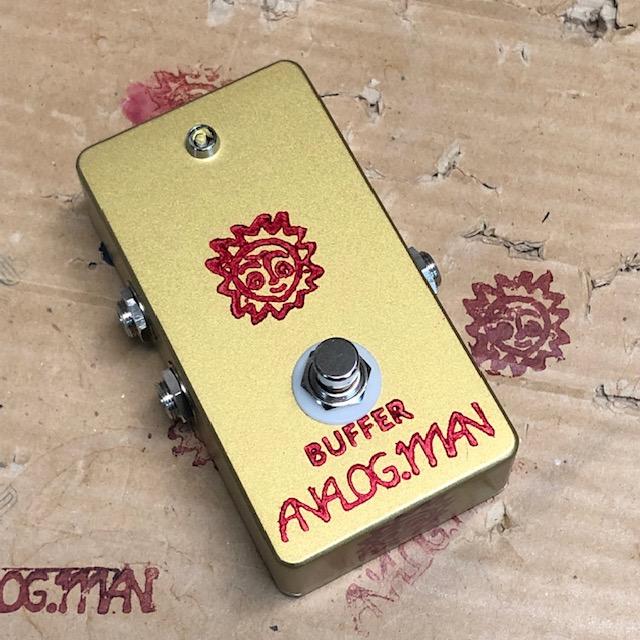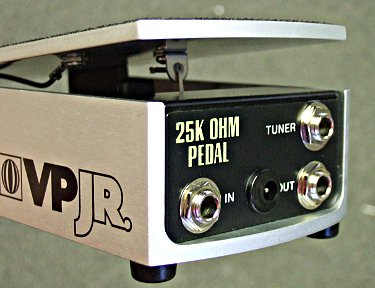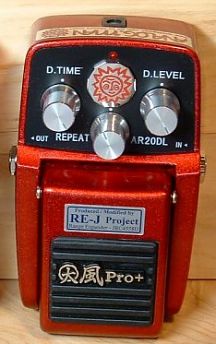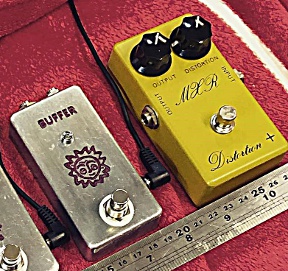Features
Analog Man BUFFER

What is a buffer?
A buffer is an active electronic circuit that keeps your guitar signal strong and
preserves the frequencies of your guitar sound. If you have a good patch cord that's not
too long, and plug directly into your amp, that is the purest sound you can
get, and you don't need a buffer. But if you have long patch cords or a bunch
of effects pedals, or a pedal with a weak output, a buffer can help get your sound
back to the pure tone you are looking for.
Why do you need a buffer?
All
patch cords or Guitar Cables have some capacitance to them, especially cheaper
cables like cables with molded ends. This acts just like the capacitor on your guitar's tone knob when you
turn it down some, and rolls off the high end.
Really bad cords can suck away too much of your tone, even mids, and should probably be replaced though
a good buffer might make them usable. Some
pedals,
like old wahs, big muffs, etc also suck a lot of your tone away as they
keep the circuit connected to your signal even when they are OFF (not true bypass, or
buffered bypass). Certain pedals
have a weak output (impedance is too high) and even when they are ON, the signal will get
loaded by cables or other pedals after them. Some examples are Dynacomp/Ross type compressors,
some distortion pedals, etc. You can test and find these types of pedals by using long cords and
turning a buffer on and off after them - the buffer should do nothing on most pedals, but some will sound
much brighter, clearer, and louder with a buffer after them. Those pedals are helped with a buffer
following them.
Using another effects pedal as your buffer
Some pedals have BUFFERED BYPASS, and when OFF your signal goes through active
electronics and is kept strong. Ibanez Tube Screamers, Boss delays, etc have pretty good buffers.
One or two buffers or buffered pedals is good in your signal path, but you don't want too many as each
one can change your tone a bit, and can rob a little of the presence and feel of your guitar, especially
some pedals with poor sounding buffers. So replacing extra buffered pedals with true bypass pedals,
modifying them for true bypass, or putting them in a bypass loop is a good idea.
One pedal you can use for a great buffer is our ARDX20 dual analog delay- if you always leave it on,
that could be the only buffer you need. If you need NO DELAY at all, just turn
the delay level down all the way on one side and that side will just be a buffer. I find my
ARDX20 is a great way to test pedals and cords - turn the DELAY LEVEL down all the way
(for just dry sound), and turn the delay on (buffered) and off (bypass). If you
hear an improvement when ON, then your cable or pedal being tested is hurting your tone.
Where you don't want a buffer
Some pedals like the vintage circuits of a Fuzz Face or Rangemaster won't work well with a buffer or buffered
pedal before them. The buffer won't let them do their "clean up" magic and can make them sound
brittle. Put buffers or buffered bypass pedals AFTER these.

Volume pedal issues
Volume Pedals are another item that can be helped with buffers. If you use
a passive style volume pedal with high impedance, like the Ernie Ball 250K pedal, it
will work great with just your guitar plugged in and won't suck much tone. But when you
add buffered pedals in front of it, the sweep can get strange, making it hard to get the
desired volume setting. In that case, the 25K ACTIVE
Ernie Ball pedal will have a better sweep, but it NEEDS to have a strong buffer
before it or it will REALLY hurt your tone. So I think the best setup would
be the 25K volume pedal and a good buffer that's always ON before it.
We can build our buffer into one of these volume pedals to kill two birds with one stone,
and keep your pedalboard size under control. With the buffer, it will no longer work as an EXPRESSION PEDAL.
 Here is the buffer inside the Ernie Ball VP Junior 25K 6181 Volume Pedal. The pedal is
apart slightly so you can see the board. The power jack we add to run the buffer is
between the jacks.
Here is the buffer inside the Ernie Ball VP Junior 25K 6181 Volume Pedal. The pedal is
apart slightly so you can see the board. The power jack we add to run the buffer is
between the jacks.
 We can also put our buffer in the Boss FV500-L stereo volume/expression pedal.
Normally we put it in one side (Input 1/Output 1),
which is the side that has a TUNER OUT jack. We can add a second buffer to the other side if you need stereo
buffered signals. With the buffer, it will no longer work as an EXPRESSION PEDAL. You can see the
added power jack on the right side. We can also put it on the left if you specify in your order comments.
We can also put our buffer in the Boss FV500-L stereo volume/expression pedal.
Normally we put it in one side (Input 1/Output 1),
which is the side that has a TUNER OUT jack. We can add a second buffer to the other side if you need stereo
buffered signals. With the buffer, it will no longer work as an EXPRESSION PEDAL. You can see the
added power jack on the right side. We can also put it on the left if you specify in your order comments.
Other Pedals
 We can make most other pedals have BUFFERED BYPASS if there is room inside, and they
are hand wired. Our King of Tone has room in the battery compartment so we are offering
them with a buffer option or can modify yours. Some pedals like the KOT often sound better
with a buffer after them. Most people run a delay pedal or reverb after their KOT so that is usually
enough. But if your KOT goes direct to your amp, with a long cord, the buffer will certainly help
when the KOT is OFF and may help even when the KOT is ON.
We can make most other pedals have BUFFERED BYPASS if there is room inside, and they
are hand wired. Our King of Tone has room in the battery compartment so we are offering
them with a buffer option or can modify yours. Some pedals like the KOT often sound better
with a buffer after them. Most people run a delay pedal or reverb after their KOT so that is usually
enough. But if your KOT goes direct to your amp, with a long cord, the buffer will certainly help
when the KOT is OFF and may help even when the KOT is ON.
Why is our buffer a good one?
I like what a buffer does, but I don't like what it does to my tone.

Most buffers on the market are the simplest opamp circuit possible-one opamp stage
with unity gain, just a few resistors and capacitors are needed. These do the job
of having a high input impedance and a low output impedance to drive your signal
to the amp nice and strong. But many cheap buffers like that just don't sound and feel the
same as the original best tone described above - a good cord direct into your amp.
These buffers can send too much high end through, and sound brittle or HARD, not a nice feel.
Many great sounding pedals like tube screamers, etc don't run your signal directly into
the op-amp, instead they use a transistor input buffer. We use the same transistor
as an old tube screamer on the input of our buffer, with the same input impedance of 510K. We
also use the tube screamer's JRC4558D opamp
later in the circuit for a warm but clean unity gain amplifier.
There is a great article on buffers on the DIY site AMZ muzique.com where Jack says,
"An opamp is an even better buffer amplifier, though many believe they are somewhat colder
sounding and more sterile than the transistor versions. The opamp gain is exactly unity and
the output impedance is quite low; typically measured in tens of ohms instead of hundreds as
with the transistors."
We use both the transistor on the input and the op-amp on the output
for the best of both worlds - nice silky tone and strong output.
A customer wrote me a note: "I was reading on your website about buffers. So I started
messing around with an Analogman Tube Screamer before my dirt and
turning the delayed signal doen on my ARDX20 at the end of the chain (like your buffer at the beginning and end). Woah I
got all my dynamics back. Other buffers have made my dirt too raspy and
have nasty high end. Looking at other buffers output and input
impedance, maybe they are putting too much high end through?"


Our original Analog Delay, the ARDL20, had buffered bypass and customers raved about
how great the buffer was in that pedal. While on or off, it would keep your signal
strong and sweet. We use the same buffer circuit in our ARDX20 dual analog delay but it has true bypass,
so when OFF there is no buffer. But you can use an expression or volume pedal in the FX loop
to kill the delays if you want just the buffer, or turn the level down.
This circuit is much more complex than a normal buffer but we feel it's worth it
as it gives a more natural feel and balance, warm with a touch of compression and natural
frequency response but without changing your tone. We want it to sound and feel just like a
10 foot high quality patch cord direct into your amp. A virtual cable!
Voltage
Our buffer will run fine at 9V off a battery or normal power supply.
If you have a really loud signal, you can run it at higher voltages like 18V for more headroom.
A normal guitar level signal will be fine at 9V but if you run a LOUD booster, or your
signal is at LINE LEVEL (keyboards, or effects loop) then higher voltage may be required
to keep your signal clean.
We don't like to put voltage boosting circuitry inside pedals as it adds complexity and
can add noise. With all the great power supplies out there now, you can usually get
whatever voltage you want. The 12V "ACA" setting on a Voodoo Lab power supply would
be an excellent choice as it's regulated and filtered for low noise. The LINE6 output
is not regulated when the DIP switch is on, so it can be noisy. Or run the 18V Y cable
from any two outputs that have the DIP switch OFF. The buffer may be a little noisy
with some digital switching power supplies like the 18V Boss supply we sell so best to
use a transformer-based power supply (Boss style PSA-120 wall wart, Voodoo Lab, Cioks,
T Rex, Dunlop, etc).
Our buffer draws about 10mA, or only 5mA with no LED.
Options



Wah Retrofit
We can optionally use the FOXROX ELECTRONICS Wah Retrofit instead of our buffer circuit. They both work about the same, the difference is the Wah Retrofit has a trimpot to set the level, it comes set to unity gain like ours, but can be made a little quieter or louder if desired.
SIZES
We can make this buffer in any of our boxes, with almost any feature you would want.
The smallest and simplest is the tiny box (1 1/2" wide, 3 1/2" long, and 1 1/4" tall) with power jack and no switch or LED, also
no room for a battery. It does have room for a second power jack if you want.
We can put the jacks on one side on the tiny box if that works better for you.

We can also use the MXR size small box (2 5/16" x 4 5/16" 1290 / 1590B) which will fit a switch,
LED, Battery, etc. We can build them into any of our switchboxes, might be nice to
get a TUNER MUTE SWITCH to get your tuner and it's cable out of your signal path,
with a buffer to buffer the rest of your signal. See our
SWITCHBOX PAGE for some samples and more info.You can also add a second output jack to this buffer with switch. Let us know how you want the switch and second output jack to work in the order COMMENTS area:
1) Switch turns the buffer on or off, both outputs are the same (splitting your signal).
2) Switch chooses between the 2 outputs, buffer is always on (for tuner mute or A/B switching)
or if you want something else, please ask first.
If you get a switch, I recommend the LED option so you know if it's ON or OFF, also useful for debugging power supply issues.
BUFFER JUNIOR - Top jacks, low profile, small size!
Junior size is approximately 2" wide X 4" long X 1 1/4" tall.

All Analog Man buffers are hand made in the USA.
|


 Custom Buffer Exactly as Hoped
Custom Buffer Exactly as Hoped 


